Rome’s Centro Storico in lockdown: An eerie stroll through a silent and empty neighborhood on edge of despair
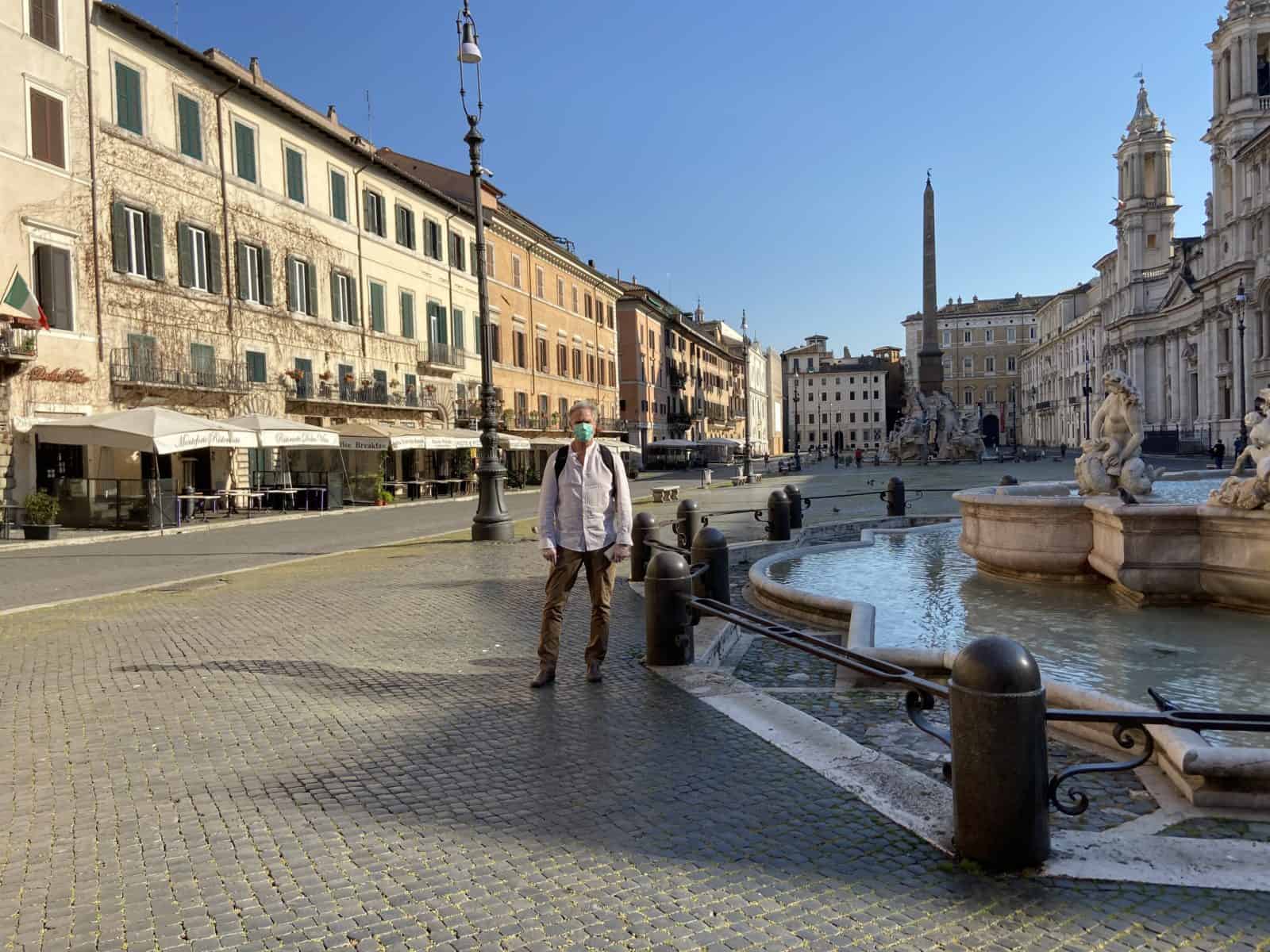
The only beneficiaries of the coronavirus quarantine are cats.
Think about it. They have all these laps to sit on and sleep on all day. Lots of hands to pet and stroke them. Someone is always there with thumbs. Owners can open a can of catfood at the first meow. The coronavirus turned them from pampered to princes and princesses.
Then I had a weird, eerie experience. I went to the center of Rome.
I stopped by the Torre Argentina Cat Sanctuary. It’s a cat shelter housed in a block full of 4th century BC ruins. If you go to the corner, just a few steps from the sanctuary office, you’ll see where Julius Caesar was murdered. The sanctuary usually has about 400 cats who sleep and play and walk among blocks of marble big and small. They’re fat and happy with an ever-present crowd of tourists who come by and pet them on the steps.
When you’re not looking, one will hop on your lap and go to sleep before you can alert authorities.

But on this day, a bright and sunny Friday afternoon, the cats were alone. No tourists offered a comforting stroke, or a tickle under a chin. Cats sat on ruins. Some slept. All looked bored and terribly lonely.
No human was anywhere in sight except me and my girlfriend. We had a rare experience. I was on assignment to walk through deserted Centro Storico during the sixth week of Italy’s lockdown.
On the opposite side of Torre Argentina, a string of taxis looked more out of place than sailboats in the Sahara. No one needed a ride. Hardly anyone walked the streets. For nearly two months, every resident in Italy who leaves home must have a government-issued auto certification stating one of four reasons we left: health, work, an emergency or necessity such as groceries, post office or pharmacy. I was equipped with my form with “Comprovate esigenze lavorative (working needs).”
In 2002, when I lived in Rome my first time, I volunteered at the cat sanctuary and I feel assured the directors come regularly to feed and care for their cats. Cats in Rome are revered. But during this lockdown, walking around Centro Storico, I couldn’t help but feel for their suffering in the throes of their own isolation and the suffering of their surrounding human inhabitants.
Centro Storico deserted
Rome averages about 10 million tourists a year. It’s a safe bet all 10 million visit Centro Storico, the city’s historical center which has been inhabited for 2,000 years and is walking distance from the Colosseum and Forum. During a two-hour passeggiata, or stroll, around one of the most popular tourist centers on Earth, we saw maybe 30 people. They were all locals walking their dogs or returning from shopping or lonely merchants. There were just as many soldiers and police making sure no one was outside without permission.
It was as if this city of 2.8 million fled after a warning of a pending earthquake that never came.
The heartbeat of Rome has flatlined. Our favorite restaurant in Rome, Renato e Luisa, looked even more dark than usual down its narrow Via dei Barbieri. I called the co-owner, Renato Astrologo, and he said he’s starting food deliveries.
“I often go to the restaurant, it’s really very sad,” Renato told me. “There isn’t anybody. The atmosphere is like a film, a science fiction film.”
Marina and I walked across the street past the yawning cab drivers and looked at Feltrinelli, my favorite bookstore with one of the few English-language sections in town. I looked at it through an iron gate.
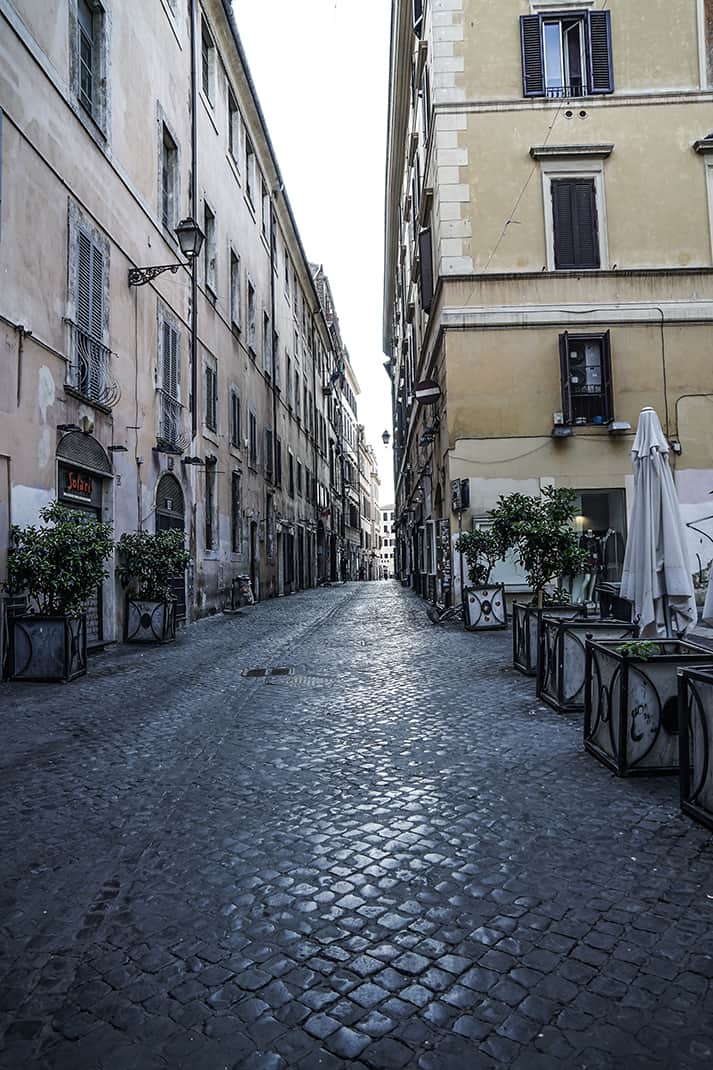
We walked down Via di Torre Argentina, the narrow street that runs from Torre Argentina toward the Pantheon. It was deserted. Not a soul could be seen. Not a business without a locked door, not an apartment above with an open window.
Then I saw something I hadn’t seen my first 15 minutes: an open door. A pizzeria take away business called Vini & Cucina Blasi was open. A dapper middle-aged man sat in a chair looking bored to the point of comatose. Dressed in a sharp blue blazer and white kerchief, he saw me peeking inside and hopped up as if I was his long-lost brother.
He hustled over and told me he has started delivering food. He’s getting about 30 orders a day and as I walked away, he ran over and stuffed two fliers in my hand. I said, “In bocca al lupo. (Good luck.)” Hmm. Margherita and spicy salami pizza for only 7 euros. It’s worth a plug (349-541-9810).
We walked down the empty street. We saw one woman walk by with a bag of groceries. That’s it. No line of Asian tourists following a woman with a hat and a little flag. No trattorias filled with customers. Not a souvenir in sight.
When we reached the back of the Pantheon, we reached our first checkpoint. Two soldiers looked at us curiously. They asked us for our documents and we handed a sheaf of papers. They were friendly and courteous and seemed relieved to see another human.
I asked, “Siete in saluti? (Are you healthy?)” They smiled and nodded and waved us in.
The Pantheon is one of the grand symbols of Rome. The 2,000-year-old temple is Rome’s best-preserved ancient building and one of the most striking pieces of architecture in the Western world. Dating back to 125 A.D., the Pantheon lords grandly over a huge piazza. For two millenium, people have filled this piazza all year round. Pilgrims pour into the building to see the sun shine through the odd nine-meter diameter hole, the oculus, that was said to connect the temple with the gods. Lovers flirt in the middle of the square. Tourists pack the outdoor cafes drinking 5-euro cappuccinos.
On Friday, Marina and I were alone. Without a crowd, the Pantheon looks even more massive than its 140-foot height. It looks intimidating, like it’s still a center of power. Its 16 Corinthian columns, each nearly 40 feet high and made of single blocks of Egyptian granite, seem even taller, heavier. A man with a small bag walked by the temple. Passing in front of a column, he looked like a matchstick next to a redwood.
I did see another sign of life. On the left side of the piazza, Antico Salumeria was open. This Italian meat shop is famous enough to be frequented by popes. I walked in and the owner was talking to a friend. I asked him, “Come vanno gli affari? (How is business?)” He shouted, “MALISSIMO! (TERRIBLE!)” He said he gets maybe 10 clients a day, mostly police and Carabinieri. He said he didn’t know how much longer he could hold out.

This week, prime minister Giuseppe Conte announced details of Phase 2 in returning Italy back to normal. He set the date for freedom of movement, with social distancing, at May 3 and the opening of restaurants May 18. I hoped this historic, tasty little corner of Rome remained open when we returned.
Marina and I walked around the corner to Tazza d’Oro, home of the world’s best — and this is not hype — cappuccino in Italy. It’s the only place worth violating Italy’s social code and ordering a cappuccino after noon. It’s all closed but a flier on the gate explains where you can order its coffee grounds at Tazzadorocoffeeshop.com.
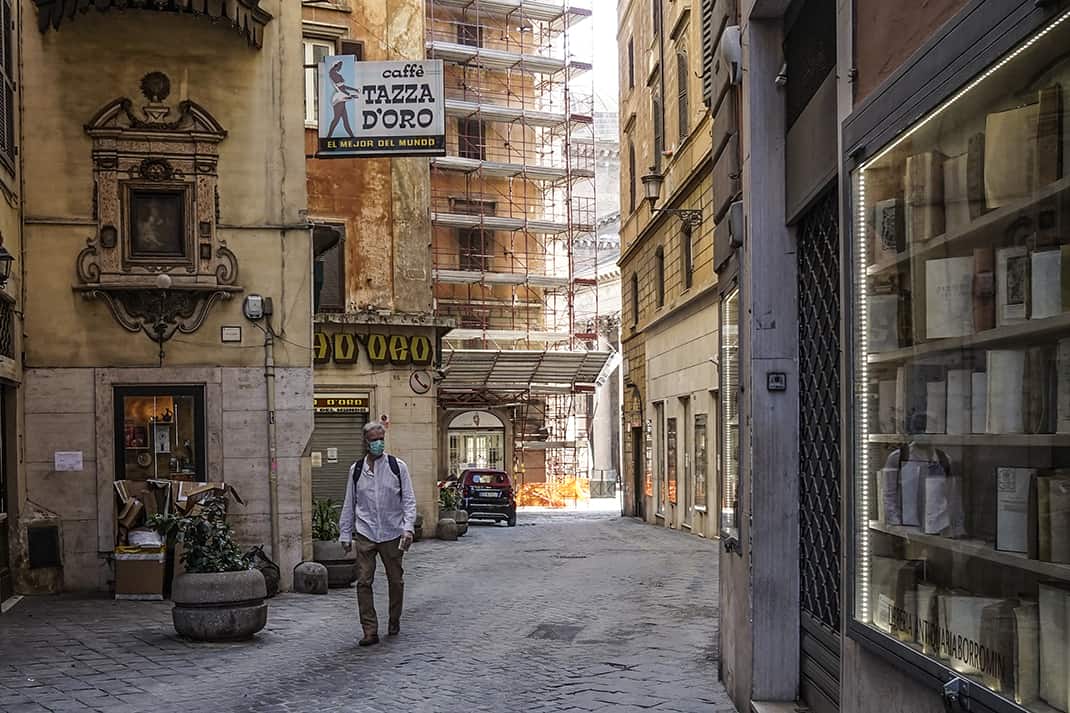
I suddenly had a gnawing craving for a coffee, a glass of wine and a bowl of pasta carbonara. After six years living in the greatest food country in the world, walking around an empty Centro Storico I felt like a drunk trapped in a Scottish distillery with all the whiskey bottles locked in a safe. I felt empty everywhere, in my heart, my soul and, especially, my stomach.
My favorite city in the world was tailspinning toward a slow death. Behind the silent walls and empty stores were people suffering from lack of employment, money and, in many places, food. According to Corriere della Sera, Italy’s most influential newspaper, Rome is expected to lose 1.5 billion euros in tourism dollars. Restaurants are losing an estimated 3 million euros a day. The government sent out a 400 billion euro stimulus package for Italian businesses in need. But how long can a government support a nation of 60 million people?
Curves flattening but …
The question is yet to be answered. The curve of new cases and deaths is beginning to flatten. Yet each day on Facebook bulletins I herald “only” about 3,000 new cases and 600 deaths. In relative terms, the numbers are getting smaller. Yet in raw terms they remain astonishingly high. Tuesday’s 602 deaths are fewer than the 919 from March 27, but that’s still 602 grieving families. That’s thousands who lost fathers, mothers, sisters and brothers. That’s 602 funerals of victims of the “mostra invisibile (invisible monster)” which hasn’t stopped its swath through my beloved, adopted country.
How many tears? Immeasurable.
We walked down empty alleys and streets. Occasionally, a woman with a dog or a shopping bag, with a baguette of bread sticking out of the top, walked past to one of the many tiny apartments sprinkled throughout the Center. We crossed the wide, regal Corso del Rinascimento and Marina showed me a tiny entrance to Piazza Navona.

Piazza Navona may be Rome’s biggest piazza. It’s certainly the most majestic. It’s anchored by Gian Lorenzo Bernini’s 17th century Fontana dei Quattri Fiumi (Fountain of the Four Rivers) in the middle. It’s lined by Francesco Borromini’s baroque Chiesa di Sant’Agnese in Agone and the huge Brazilian Embassy and its giant green, yellow and blue Brazilian flag.
This piazza, 900 feet long and 350 wide, once held a 30,000-seat stadium for athletic games and was occasionally flooded for mock naval battles. All year round it is filled with people, locals on a stroll, street artists selling their paintings and sidewalk cafes packed with tourists in shades with glasses of wine over heaping plates of pasta.
On Friday we saw four people.
An elderly man in a ball cap walked briskly around the piazza on what may be his daily rounds. He strolled past a man in a hoodie and tennis shoes doing pushups on a marble bench. Above me a man on a tiny apartment balcony, snoozed in the brilliant 70-degree sunshine. Hanging above him, like a banner of hope, was the Italian flag.
I’ve seen Piazza Navona this empty before — in winter at dawn, when the fog settles over the cobblestones and even a hack photographer like me can produce photos that can take a viewer’s breath away. But this was 5 o’clock on a 70-degree, sunny Friday afternoon in April, the start of the tourist season. We heard more sounds from seagulls than we did people.
My favorite street deserted
We exited the end of the piazza and turned right up one of my favorite streets. Via di San Pantaleo is home to Cul de Sac, with arguably the largest wine collection of any wine bar in Rome. It turns into Via del Governo Vecchio where you find Enoteca il Piccolo (Little Wine Bar) with its tiny, romantic setting and the three or four small tables outside where the locals hold court.
They were both shuttered. Not a chair or table in sight. What seemed missing most was laughter. This is the heart of la dolce vita. Good friends. Good wine. Good weather. Good surroundings. Everyone seems happy in this part of Centro Storico.
Instead, all I saw was a leaf blowing across the cobblestones and a box with free books for the taking stood unattended. I walked past Pasquino Pizzeria, a popular tourist spot but now left with only business cards hanging from the window next to an advertisement for delivery service.
I looked above us. More Italian flags than usual hung in the sun.
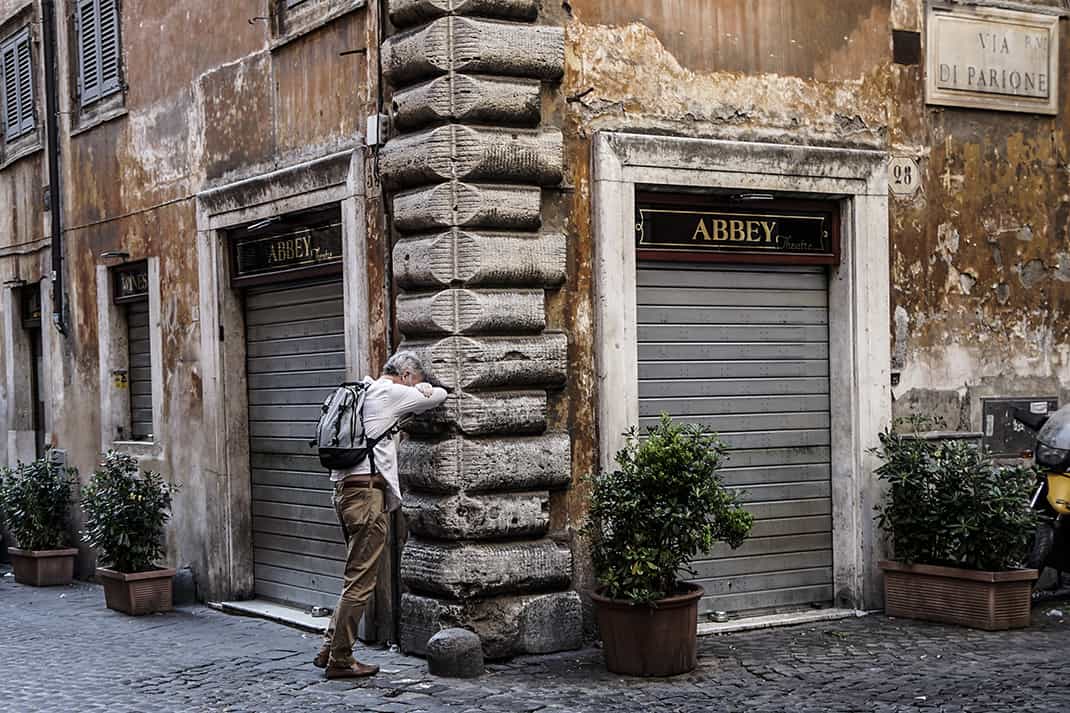
We continued down Governo Vecchio to one of my favorite corners in Rome. It’s here, at Abbey Theatre Irish Pub, where I spend one or two nights a week nine months a year. It’s where I gather with my fellow Romanisti in the upstairs room and cheer on our beloved and starcrossed A.S. Roma. It’s my Cheers, where the friendly staff all know my name and remember to serve me a My Antonia Italian craft beer when I walk in.
The iron shutter is down. I couldn’t hear Mike the Irish bartender making people laugh. I couldn’t smell the best fish ‘n chips this side of Liverpool. Soccer is shut down until May 31. It has been five weeks since the last game. I’d give anything for just a corner kick.
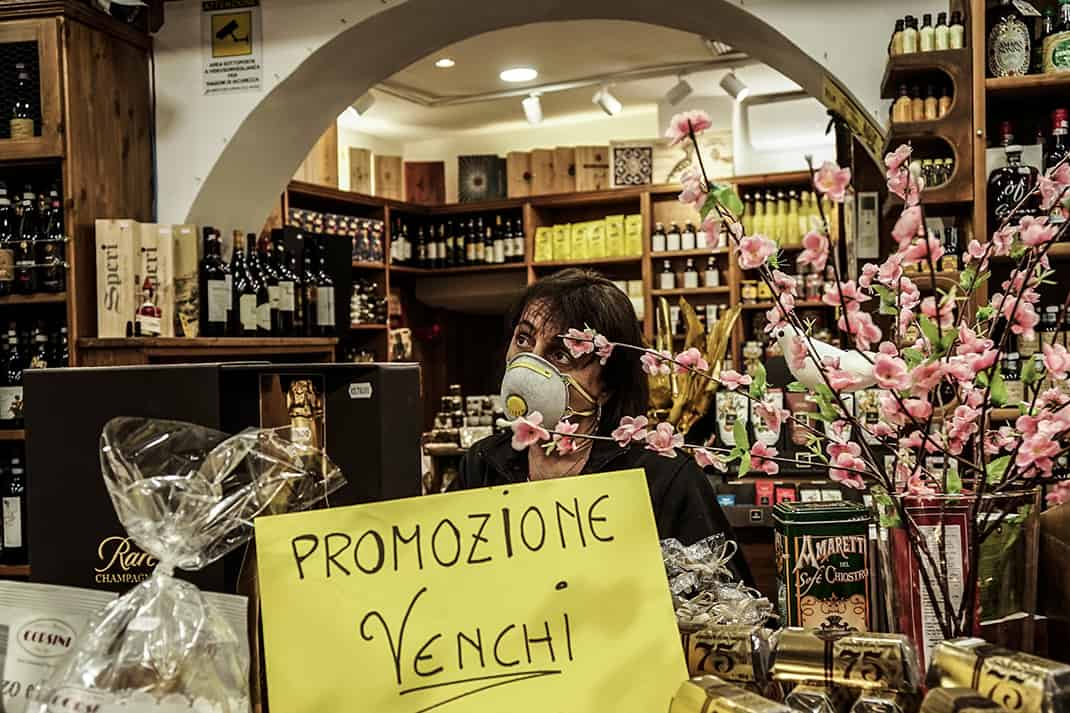
Across the narrow street is Enoteca Guerrini, a family run souvenir shop selling limoncello in every flavor of the fruit tree and always packed with tourists. We were the only visitors. A clerk wearing a mask told me she gets about 15 customers a day. I asked how she is holding up.
“It’s very, very, very hard,” Cristiana Checcoli said in passable English. “But we like to be positive. We like to say everything is possible. We trust it’ll become better.”
It was nearing 6 p.m. In my fifth week of lockdown and feeling too empty to drink alone at home, I was dying for a glass of wine. I took Marina across busy Corso Vittorio Emanuele and we negotiated the maze of narrow alleys and streets to Via dei Banchi Vecchi. It’s one of the quaintest streets in the Center, lined with boutique shops, some lovely trattorias and emptying out into underrated Piazza Farnese, home to the beautiful French Embassy.
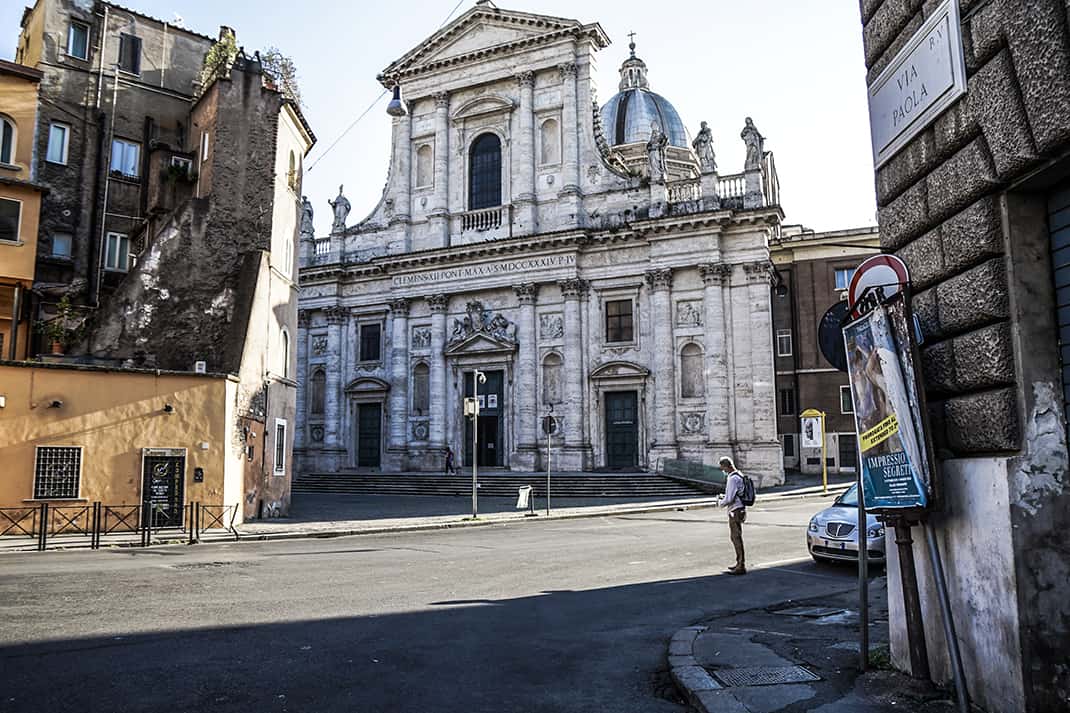
It’s also home to Il Goccetto, my favorite wine bar. It’s where an affordable selection of great Italian wines are written fresh on a chalkboard every day, where stylish workers from the neighborhood offices gather after work for a glass of Montepulciano or Chianti Reserva. At night, the crowds spill onto the street. The police never bother with a crowd holding glasses near passing cars and pedestrians. This clientele is too mellow.
But all I saw was a big drawing of Bacchus, the Ancient Roman god of wine, looking fat and happy and drunk, emblazoned on the closed iron door.

It was time to go. On the way to my tram stop, we passed through Campo de’ Fiori, Centro Storico’s teeming party center. The Drunken Ship bar didn’t have a drunk and the barkers who usually try luring me into their outdoor restaurants were nowhere to be found. The statue of Giordano Bruno, the philosopher who was burned at the stake for heresy in the middle of the piazza in 1600, seemed even more lonely than usual.
It was 7 p.m. and the sun was setting on the city in more ways than one. We had just experienced something special. We had strolled through one of the world’s most beautiful, most historic neighborhoods, nearly all by ourselves.
Yet we did it with a backdrop of death. My adopted country is fighting fiercely to right itself after so many weeks being the beacon an infected world looked at for hope. The coronavirus has killed more than 21,000 people in Italy and its beautiful capital is as empty as a gilded Easter egg.
I felt just as empty. I keep repeating the phrase that has swept Italy since the virus arrived: “Andra’ tutto bene (Everything will be alright).” But after walking through the silent piazzas and past the dying trattorias and around the empty churches, I started feeling a lot like the cats in Torre Argentina.
We are very much alone.


April 16, 2020 @ 7:26 am
God bless Rome. AS Roma and S.S lazio !
April 16, 2020 @ 7:27 am
God bless Rome ! AS Roma and S.S. lazio !
April 16, 2020 @ 7:29 am
God bless Rome ! AS Roma and S.S. lazio !!
April 16, 2020 @ 8:09 am
Andrà tutto bene John! In bocca al lupo alla bella Italia ❤️
May 2, 2020 @ 10:35 pm
Roma resisti, ritornerai piu’ bella che prima. Rome hang on, you will come back more beautiful than before.
April 16, 2020 @ 9:31 am
Thanks for this melancholy and insightful piece.
April 16, 2020 @ 3:31 pm
I usually love Rome from afar (in NY) but I was supposed to be in Rome this entire week. Although I always looked forward to reading your blogs to get my Rome “fix” from my office chair, reading this has made me especially emotional for you and the entire city. Thank you for your articles that continue to educate and inspire…I hope to keep reading for a long time, so stay safe and best wishes for a speedy recovery of Rome.
April 16, 2020 @ 3:53 pm
John, thanks for the heartfelt account. Hang in there. Sometime relatively soon your favorite streets and haunts will be filled with people once again. I hope you can find comfort in Marina’s beautiful photos showing the unrelenting beauty of Rome.
On a lighter note, I found Caffe Tazza D’Oro’s hanging shingle to be amusing. I can’t wait to compare their cappuccino to what I enjoyed at Cafe Sant Eustachio around the corner from the Pantheon some years ago!
April 22, 2020 @ 11:30 am
Thanks, Elise. Rome will heal. It always does. I still would rather not be anywhere else.
April 22, 2020 @ 11:31 am
Thanks, Mike. Do I know you?
April 16, 2020 @ 6:09 pm
So hard to see my beloved city so empty.
April 16, 2020 @ 10:23 pm
It’s sad to see it so empty. But it must be beautiful, in a tragic way, for a resident to see the city that way. With any luck, this will be a relatively short, and once-in-a-lifetime, event.
April 17, 2020 @ 8:49 am
Rome is my favorite city. My husband and I visited every year including 2016 when he was diagnosed with brain cancer. He died a few weeks after we returned to Atlanta. I’ve been back to Italy twice with my stepdaughter and her husband. We sprinkled some of my husband’s ashes at the cat sanctuary. It is such a wonderful place. Thank you for continuing to salute the people and beauty of Italy. I look forward to coming back.
April 22, 2020 @ 11:32 am
That’s a lovely gesture for your husband, Lyndel. I am sure the cats drew inspiration from the ashes.
April 17, 2020 @ 10:00 am
I was supposed to arrive today, for a 10day work trip…something I do 3-4 times a year. It was familiar to read your post here, thank you. I am dearly missing the Eternal City, but more so, grieving and praying for all of you Romans. Hang in there. Pax et bonum.
April 22, 2020 @ 11:33 am
Thanks for the note, Marco. Be patient. Come back. Rome isn’t going anywhere.
April 17, 2020 @ 1:12 pm
Are people feeding the cats at Argentina? There was an SPCA like adoption office there- is it still operating and taking care of the cats?
April 22, 2020 @ 11:34 am
Yes, there are people from the organization coming in regularly to take care of them.
April 19, 2020 @ 8:47 pm
Heart breaking. In 2015 we discovered Renato e Luisa and went again 2 years ago – I’m glad to hear they are okay – considering everything. Thank you for sharing the story and photos.
April 22, 2020 @ 11:35 am
Thanks for the note, Mary. I’m glad other people have discovered Renato e Luisa. I just hope not TOO many.
April 20, 2020 @ 12:07 am
my soul silent, my heart cried as read and viewed your Rome today. I’m sad for Rome and all of Italy. The Eternal City will always be eternal.
April 22, 2020 @ 11:35 am
I’m sorry I made you cry, Dede. Fear not, however. Rome has been through worse. It’ll be back.
April 27, 2020 @ 10:22 pm
Nice, John. Good to have a perspective. The first half of the 1940s didn’t go well for Rome, or Italy. Germs will do what they do to our corporeal bodies, but the beauty that is Rome will live on. Hopefully most of us will have a chance to stand among that splendor again. Soon.